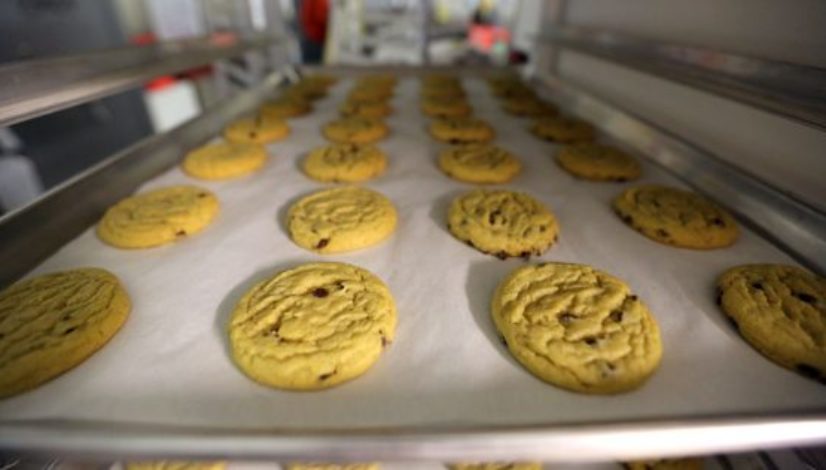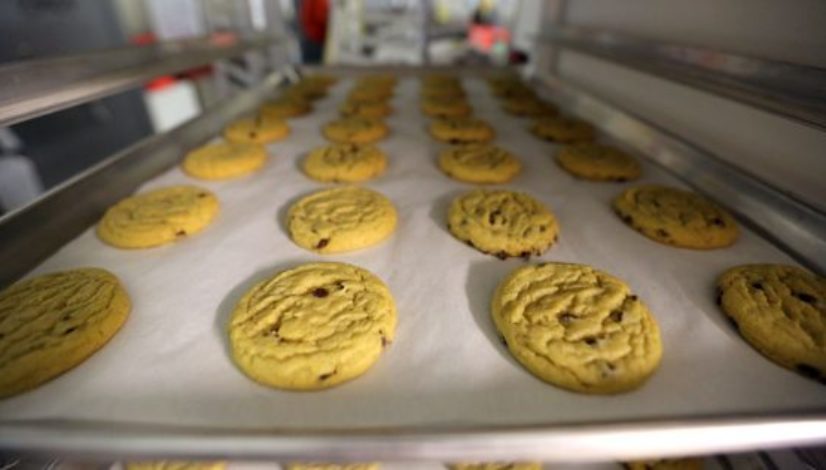Cannabis cooking formulas: Calculate low-dose THC potency for your homemade cannabutter edibles

Published: Nov 14, 2017, 1:14 pm • Updated: Nov 14, 2017, 1:14 pm
By Susan Squibb, The Cannabist Staff
Hey, Cannabist!
Here’s a cooking question: Do I use only infused butter in my cookie recipe? I used an ounce of decarboxylated homegrown Banana Kush flower and sugar trim to infuse 4 sticks of butter. My favorite cookie recipe makes 60 cookies and calls for 1 cup of butter. How can I calculate the strength of my cannabutter, and what are my options for controlling potency in the cookies? I want the cookies to be about 10 milligrams THC per cookie. Thanks! –Head Cook
Hey, Head Cook!
Great question! Calculating THC potency in homemade cannabutter and edibles is an important head skill to master. Let’s review the basic formula for determining cannabutter THC content and then work out the measurements to yield 10-milligram servings for your favorite cookie recipe. Coincidentally, in Colorado, the standard serving size for a commercially made edible is 10 milligrams THC.
A caveat before we get started: Unless you obtain analytical test results on your fresh-baked cookies, please keep in mind that calculating the THC in homemade cannabutter and edibles are rough estimates at best because there are many variables in play. But this will at least help you know if your cookies are on the “mildly potent” end of the spectrum or “super strong.”
Get out your scratchpad and calculator, and let’s get cracking.
These are the key numbers to know:
- Percentage of THC in the strain
- The recipe yield
- Total THC in your cannabutter batch
- Cooking measurement equivalencies
 Cannabutter and regular butter in a mixing bowl. (Brennan Linsley, Associated Press file)
Cannabutter and regular butter in a mixing bowl. (Brennan Linsley, Associated Press file)
Your cannabutter recipe calls for one ounce of marijuana and four sticks (one pound) of butter, the same ratio used in The Cannabist’s how-to for making cannabutter, written by chef Laurie Wolf.
Kudos to you for prepping your buds and trim for your recipe with a decarboxylation step. This will help optimize the THC in your plant material. For the uninitiated, decarboxylation is the process of activating cannabis flower or trim with heat to transform the non-intoxicating THC-A cannabinoids into psychoactive THC, as would happen when you light up a joint. Different chefs have different time and temperature recommendations. Wolf suggests heating marijuana in a 240-degree oven for 40 minutes.
Now, let’s estimate the cannabutter potency.
Step 1: How potent is your weed?
We need to know the THC percentage of the homegrown Banana Kush flower and trim. Some variables in potency of flower or trim depend on the plant characteristics and the growing cycle.
You could do some online research for potency results for whatever strain you’re working with. Some searching on Banana Kush shows THC potency of 16-27 percent. That’s a significant variance and this also illustrates why these cannabutter calculations should be considered only a best guess.
For convenience and ease, we’ll use a 17 percent THC potency for our calculating — that’s the average potency of marijuana flower sold in licensed Colorado shops, as determined by a 2015 state-commissioned study.
Step 2: Go metric
Convert your measurements to the metric system. One ounce equals 128.35 grams. Convert again to milligrams – 128.35 grams is equivalent to 128,350 mg.
To calculate the total THC potency of the Banana Kush, multiply the total weight of flower (in milligrams) used in the cannabutter batch by the THC potency percentage:
128,350 x .17 = 21,820 mg
So, there are 21,820 mg of THC in the batch of cannabutter.
Step 3: Convert those cups of butter into grams
Next, figure the milligrams per gram (mg/g) of the cannabutter batch. We’ll tally using the metric equivalent of one pound of cannabutter, which is 454 grams.
As you recall, you infused four sticks of butter. Therefore, a single stick of butter is 113.5 grams (we’ll be using this figure in a bit).
In reality, the total yield of cannabutter will not remain 454 grams. There is loss of butter weight after heating and filtering the butter to remove the plant material. To be more accurate in your calculations, if you have a food scale you could measure your final cannabutter yield and plug that number into the formula instead of 454 grams. But hey, we’re estimating here:
21,820 mg / 454 grams = 48 mg/g
There are approximately 48 milligrams of THC in each gram of cannabutter.
Step 4: Get some non-infused butter ready to use
While we figure out how much cannabutter is needed in the recipe, start softening two sticks of regular butter (non-infused) to room temperature. You will definitely not need to use just cannabutter for these single-serving cookies.
Since you want each cookie to contain about 10 mg THC, multiply that by the recipe yield (60 cookies) to get the total amount of THC needed.
10 mg X 60 = 600 mg
Phew, that was easy. You need a total of 600 mg THC for this cookie recipe.
Step 5: Some final cooking conversions
So, how much cannabutter would contain 600 mg THC? Based on earlier calculating, we know there are 48 mg THC in each gram of cannabutter.
600 mg / 48 mg/gm = 12.5 grams (round up to 13)
Therefore, 13 grams of Banana Kush cannabutter are needed to make 60 cookies with 10 mg THC per serving.
How much regular butter do you need for your cookie recipe? Remember, the cookie recipe called for one cup which is equivalent to 227 grams. 227 grams minus 13 grams of cannabutter is 214 grams of regular butter.
We’re almost there.
Here’s the final calculation needed to add the right amount of cannabutter: How many grams are in a tablespoon of butter?
A single stick of butter weighs 113.5 grams. There are 8 tablespoons per stick of butter. So:
113.5 gm / 8 Tbs = 14 gm/Tbs
Your cookie recipe calls for a total of 1 cup butter — the equivalent of 2 sticks or 16 Tbs — so you’ll need a little less than 1 Tbs cannabutter and a tad more than 15 Tbs regular butter to hit your THC per-serving goal.
Step 6: Homogenize your cannabutter before making the cookie dough
Eliminate or reduce some inherent variability of THC potency by adding care at three points in the cookie making:
A) Before you begin, homogenize the cannabutter to make the potency consistent throughout the whole batch. Heat all the cannabutter at a low temperature, just warm enough to liquefy it. Gently, but thoroughly, stir until it’s completely blended.
More on cannabutter
- Warm your belly: A spicy weed recipe for White Sweet Potato Soup
- Love cooking, eating and weed? You’re in luck, this chef’s cooking with cannabis classes are for you
- Foodies rejoice: Are high-end cannabis-infused dishes the future of getting high?
- How to plan a pot-infused dining experience: Start the meal off right
- Cannabist Show: He reforms pot laws; She’s a cannabis chef
B) When you are making the batter, incorporate the regular butter and cannabutter thoroughly with the wet ingredients. Homogenous batter will have a more consistent distribution of THC throughout the cookie dough. Keep in mind if you use other cookie recipes loaded with chocolate chunks, chopped nuts, oats, dried fruit or other additional delicious ingredients, you will want to thoroughly mix the ingredients and evenly distribute the cannabutter batter.
C) Divide up your dough into evenly-sized baking portions before you start placing on the baking sheet. You’ll likely want to bake 12 cookies in five batches, so make five evenly-sized portions. And keep your spoons of cookie dough a consistent size.
One last thing to consider
Before you get back to baking, one final note about portion sizes. If you’re sharing your cookies with other adults in a recreational setting, I recommend using less cannabis in the recipe to lower the THC dosage per piece, so people can eat two or three cookies and not overindulge in THC.
Baking aside, for your safety and lawful enjoyment of the fruits of your labor, keep up to date with state laws and local ordinances regarding home-grows in your area. XO
Ask The Cannabist: Clearly you have questions about marijuana, be it a legal concern, a health curiosity or something more far-reaching. Email your queries to [email protected].
Home cooking: We’ve got our weed recipes sorted,
appetizers || entrees || desserts
Topics: cannabutter ratio, cooking with cannabis, cooking with cannabutter, edibles, edibles advice, thc, thc content in edibles  Susan Squibb
Susan Squibb
Susan Squibb, the Cannabis Maven, is a Denver-based freelance cannabis writer and an operations management consultant. She founded and organizes the event, Mother’s High Tea. Connect with her on LinkedIn, Twitter and…




